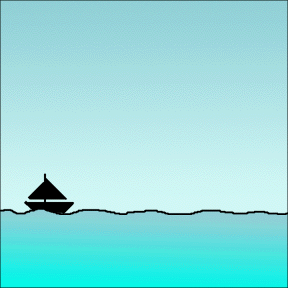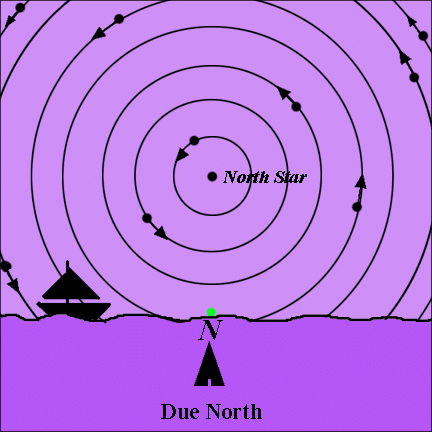

 | "Imagine that you are in a sailboat. You are faced with the problem of crossing the three thousand miles of open ocean that separate New York and London. You are told that the direction (in nautical terms, 'bearing') you want to go in to get to London is roughly northeast. But you have no instruments of any kind to help you! Once you leave visible landmarks near the shore, everything from horizon to horizon is just water, all of which looks pretty much the same! How are you going to find your way?!" |  |
 | "A good question! But first of all, what does northeast mean?" |
 | "Well, Lou, the earth rotates about an imaginary line called its AXIS. The two points on the earth's surface where the axis emerges are called the 'NORTH POLE' and the 'SOUTH POLE.' Any line pointing along the Earth's surface towards the North Pole is said to be pointing 'north.' Any line pointing along the Earth's surface towards the South Pole is said to be pointing 'south.' 'East' is at right angles to north in a clockwise direction; 'west' is at right angles to north in a counterclockwise direction. 'Northeast' is the direction halfway between north and east!" |  |
 | "I got it! But be practical, Lulu. There you are in the middle of the ocean. Nothing to see but water in every direction. How do you know which way is north? Or any other direction!?" |
 | "What do you think you could see that would always be in the same direction?" |
 | "How about the sun?" |
 | "Well, your thinking is up in the air, Lou, which is where it should be! But the sun isn't so easy. The trouble with the sun is that its position is always changing - it changes with the time of day and it changes throughout the year! But when it's at its ZENITH, the highest point that it reaches each day, it is directly south if you're north of the equator, and directly north if you're south of the equator!" |  |
 | "That sounds pretty good!" |
 | "Yeh! But how easy is it to know when it's reached its highest point? It can be done with an instrument called a SEXTANT, but it takes some skill! But remember! You don't have any instruments! But all (and you) is not lost! Strangely enough, in some ways it's easier to get direction at night!" |
 | "You mean the stars!" |
 | "Not any star, Lou, but a particular star. As the Earth rotates on its axis, all the stars except one appear to move in circles across the sky during the night. The only star that doesn't seem to move is 'alpha Ursae Minoris!' To you, the 'North Star!'" |  |
 | "OK, so to go north, you go towards the point on the horizon directly beneath the North Star (the green dot). But what do you do when it's cloudy or it's daytime?!" |
 | "Good questions! Now we have to allow you an instrument! You could use...a compass! Go to 'Direction' and click on 'The Compass'!!"" |
©2000
David J. Leveson